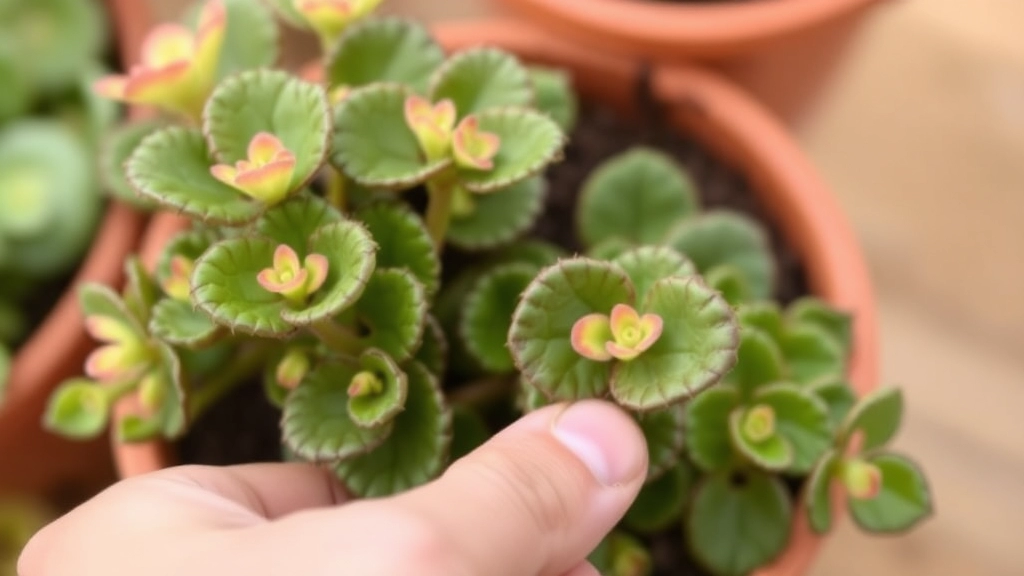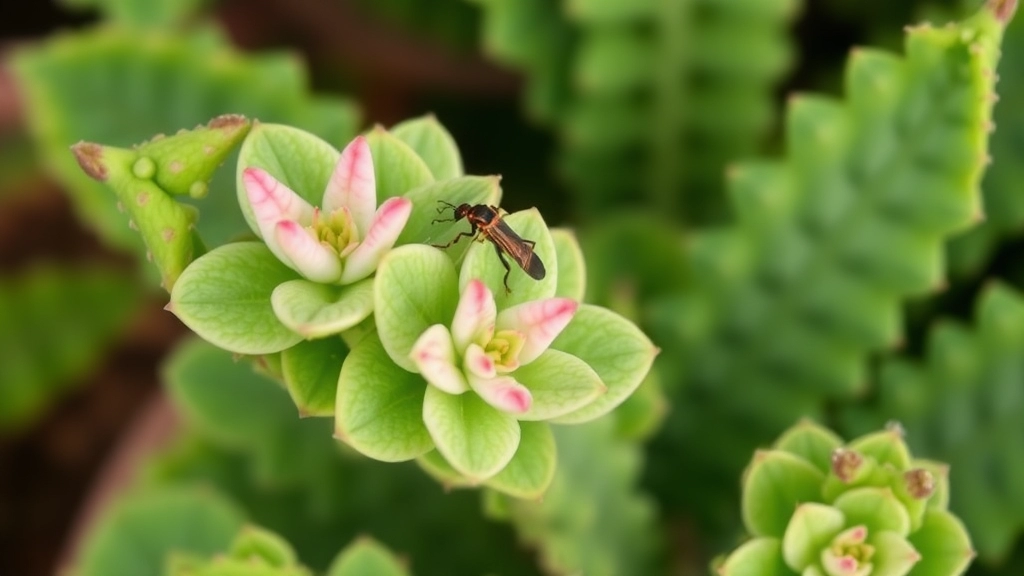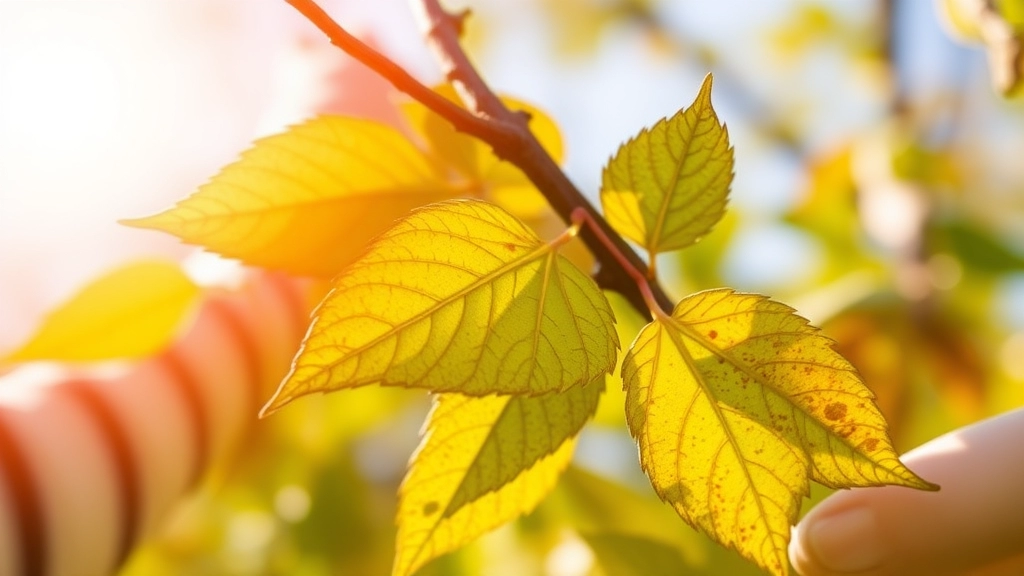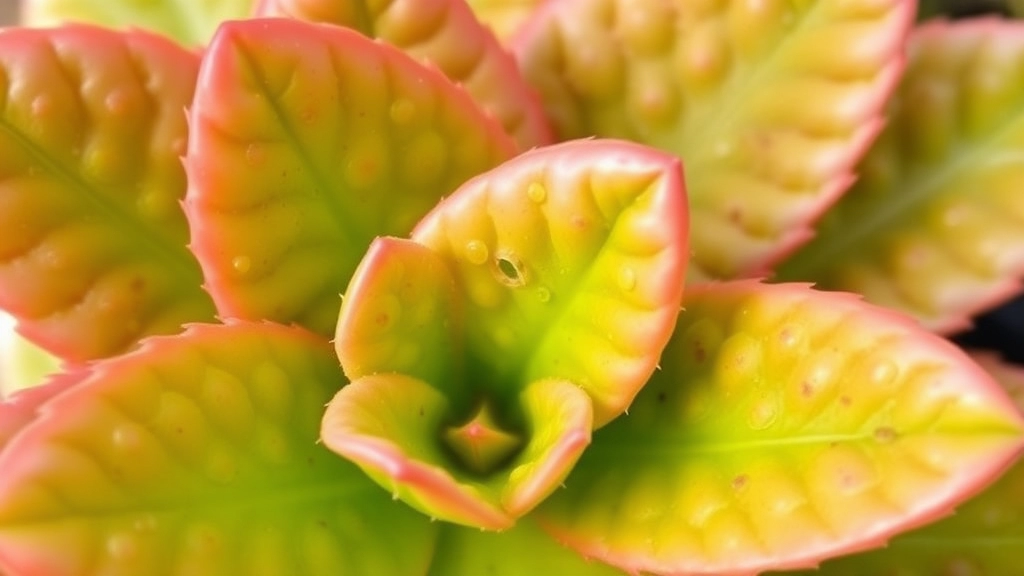Kalanchoe Leaf Problems
Struggling with Kalanchoe leaf problems? You’re not alone. From discoloration to pesky pests, these issues can be frustrating. Understanding the common causes like overwatering, root rot, and powdery mildew is the first step to restoring your plant’s health.
Pest Management
Dealing with mealybugs, aphids, and scale insects? We’ve got practical solutions to keep these pests at bay. Plus, learn how to prevent fungal infections and manage humidity and light levels for long-term care.
Best Practices
Let’s dive into the best practices for maintaining vibrant Kalanchoe leaves.
Common Causes of Kalanchoe Leaf Discoloration
Kalanchoe plants are beloved for their vibrant foliage and stunning flowers, but leaf discoloration can be a source of concern for many plant enthusiasts.
What causes those leaves to lose their luster?
Here are some common reasons for Kalanchoe leaf discoloration:
1. Overwatering
- Symptoms: Yellowing leaves, mushy texture.
- Cause: Excess moisture leads to root rot, affecting the plant’s ability to absorb nutrients.
2. Underwatering
- Symptoms: Leaves may appear shrivelled or brown at the edges.
- Cause: Insufficient water can stress the plant, leading to discoloration.
3. Nutrient Deficiency
- Symptoms: Pale or yellow leaves, particularly older leaves.
- Cause: Lack of essential nutrients, such as nitrogen or magnesium, can cause leaves to lose their vibrant colour.
4. Sunburn
- Symptoms: Brown, crispy patches on leaves.
- Cause: Too much direct sunlight can scorch the leaves, leading to discoloration.
5. Pest Infestation
- Symptoms: Discoloration often accompanied by visible pests or sticky residue.
- Cause: Pests like aphids or mealybugs can sap the plant’s vitality, causing leaves to change colour.
6. Fungal Infections
- Symptoms: Dark spots or patches on leaves.
- Cause: Fungi thrive in overly moist environments, leading to leaf discoloration.
If you’re experiencing issues with your Kalanchoe, consider checking out our guide on why Kalanchoe flowers lose color for more detailed solutions. Additionally, for those who want to ensure their plants remain healthy and vibrant, our complete guide on caring for Kalanchoe succulents offers comprehensive tips and advice.
Identifying Overwatering and Root Rot in Kalanchoe

Ever looked at your Kalanchoe and thought, “Why are my leaves turning yellow or mushy?”
You’re not alone.
Overwatering is one of the sneakiest culprits behind Kalanchoe leaf issues, often leading to root rot if not caught in time.
Signs of Overwatering
- Yellowing Leaves: The first sign to watch for. If your leaves are turning yellow and feel soft, it’s a red flag.
- Mushy Stems: Give those stems a gentle squeeze. If they feel squishy, you might have a problem.
- Foul Odor: A rotten smell coming from the soil? That’s a sure sign of root rot.
How to Check for Root Rot
- Inspect the Roots: Gently remove the plant from its pot. Healthy roots are firm and white. If they’re brown and mushy, root rot is likely.
- Soil Condition: Is the soil soggy? If it clumps together and doesn’t crumble, it’s holding too much water.
- Pot Drainage: Ensure your pot has drainage holes. If not, it’s time to repot into one that does.
What to Do Next
If you spot these signs, don’t panic. Here’s what to do:
- Let It Dry: Remove the plant from its pot and let the roots dry out for a few hours.
- Trim Affected Roots: Cut away any mushy parts with clean scissors. Make sure to sterilise your tools to prevent spreading disease.
- Repot: Use fresh, well-draining soil and a pot with drainage holes.
- Adjust Watering Schedule: Allow the top inch of soil to dry out before watering again.
Understanding Powdery Mildew on Kalanchoe Leaves
Have you noticed a white, powdery coating on your Kalanchoe leaves? This could be a sign of powdery mildew, a common fungal disease that can affect your plant’s health.
What is Powdery Mildew?
Powdery mildew is a fungal infection that thrives in warm, dry conditions. It manifests as white or greyish spots on the leaves, which can eventually lead to yellowing and wilting if left untreated.
Identifying Powdery Mildew
To effectively manage powdery mildew, it’s important to identify its presence early. Look for these signs:
- White Powdery Spots: Initially appear on the upper side of leaves.
- Distorted Growth: Leaves may curl or become deformed.
- Yellowing: Affected leaves may turn yellow and drop off.
Causes of Powdery Mildew
Understanding what leads to powdery mildew can help you prevent it:
- High Humidity: Excess moisture in the air can promote fungal growth.
- Poor Air Circulation: Crowded plants can trap humidity and create a breeding ground for mildew.
- Overhead Watering: Watering leaves instead of the soil can encourage the spread of spores.
Treatment Options
If you find powdery mildew on your Kalanchoe, don’t worry; there are effective treatments available:
- Remove Affected Leaves: Prune any leaves showing signs of mildew to prevent further spread.
- Improve Air Circulation: Space out your plants to allow for better airflow.
- Adjust Watering Practices: Water the soil directly and avoid wetting the leaves.
- Use Fungicides: Consider organic options like neem oil or commercial fungicides specifically designed for powdery mildew.
Preventing Future Outbreaks
To keep powdery mildew at bay, adopt these preventive measures:
- Monitor Humidity Levels: Aim for moderate humidity around your plants.
- Positioning: Place your Kalanchoe in a location with good airflow and sunlight.
- Regular Inspections: Check your plants frequently for early signs of mildew.
For more tips on keeping your Kalanchoe healthy, check out our complete care guide for Kalanchoe with pink flowers and our article on getting your Kalanchoe to bloom again.
How to Deal with Mealybugs on Kalanchoe

Have you noticed white, cottony masses on your Kalanchoe leaves? These pesky mealybugs can wreak havoc on your plant’s health. Understanding how to identify and treat mealybugs is essential for maintaining a thriving Kalanchoe.
Identifying Mealybugs
- Appearance: Mealybugs are small, soft-bodied insects that often appear as white, fluffy patches on leaves and stems.
- Signs of Infestation: Look for yellowing leaves, stunted growth, and sticky residue (honeydew) on the plant or surrounding surfaces.
Treatment Options
- Manual Removal:
- Use a cotton swab dipped in rubbing alcohol to gently dab the mealybugs.
- This method is effective for small infestations.
- Insecticidal Soap:
- Spray the affected areas thoroughly with insecticidal soap.
- Ensure you cover both the tops and undersides of leaves.
- Neem Oil:
- Mix neem oil with water according to the instructions on the label.
- Spray it on your plant to disrupt the mealybugs’ life cycle.
- Natural Predators:
- Introduce beneficial insects like ladybugs or lacewings that feed on mealybugs.
- This can help keep the population in check.
- Regular Monitoring:
- Check your Kalanchoe weekly for signs of mealybugs.
- Early detection can prevent a larger infestation.
Prevention Tips
- Quarantine New Plants: Always keep new plants separate for a few weeks to monitor for pests.
- Maintain Healthy Conditions: Healthy plants are less susceptible to infestations. Ensure your Kalanchoe has the right light, water, and nutrients.
Recognizing and Treating Leaf Spot Diseases
Are you noticing unsightly spots appearing on your Kalanchoe leaves? Leaf spot diseases can be a real concern for plant enthusiasts, and knowing how to identify and treat them is crucial for maintaining a healthy plant.
What Are Leaf Spot Diseases?
Leaf spot diseases manifest as dark or discolored spots on the leaves, often surrounded by yellow halos. These spots can vary in size and shape, depending on the specific pathogen involved. Common culprits include fungal infections, bacterial infections, and environmental stressors.
Signs to Look For
- Dark spots: Usually brown or black, often with a yellowish border.
- Yellowing leaves: This may occur around the spots, indicating a potential infection.
- Leaf drop: In severe cases, affected leaves may fall off prematurely.
Treatment Options
- Isolate the Plant: If you suspect leaf spot disease, the first step is to isolate your Kalanchoe from other plants to prevent spreading.
- Prune Affected Areas: Use sterilized scissors to trim away any infected leaves. This helps reduce the spread of the disease.
- Improve Air Circulation: Ensure your plant has enough space around it. Good airflow can help prevent fungal growth.
- Adjust Watering Practices: Overwatering can exacerbate leaf spot diseases. Make sure the soil dries out between watering sessions.
- Fungicides: If the problem persists, consider using a fungicide specifically designed for leaf spot diseases. Always follow the manufacturer’s instructions.
- Monitor Humidity: High humidity can promote fungal growth. Aim for a balanced humidity level to keep your Kalanchoe healthy.
Prevention Tips
- Choose Resistant Varieties: Some Kalanchoe species are more resistant to leaf spot diseases. Research before purchasing. For example, you can check out the comprehensive Kalanchoe species list for gardeners to find resistant varieties.
- Regular Inspections: Check your plants regularly for early signs of disease. For more detailed guidance, refer to the complete guide to Kalanchoe Mother of Thousands care and propagation.
- Proper Hygiene: Clean your gardening tools and pots to prevent the introduction of pathogens.
Managing Aphid Infestations in Kalanchoe Plants
Have you noticed tiny, soft-bodied insects on your Kalanchoe?
Aphids can be a real headache for plant lovers.
These little critters can suck the life out of your beautiful leaves, leading to yellowing and wilting.
But don’t worry, managing aphid infestations is doable with a few straightforward steps.
Identification
First things first, let’s identify if you’re dealing with aphids:
- Look for clusters: They often gather in groups on the undersides of leaves or at new growth tips.
- Check for sticky residue: This is honeydew, a sugary substance they excrete.
- Watch for ants: If you see ants around your plant, they might be farming the aphids for that sweet honeydew.
Treatment Options
Once you confirm an aphid infestation, it’s time to take action. Here are some effective methods:
- Water Spray: A strong blast of water can dislodge them from your plant. Just be careful not to damage the leaves.
- Insecticidal Soap: Spray this on affected areas, following the instructions. It suffocates the aphids without harming your plant.
- Neem Oil: This natural remedy disrupts their life cycle. Mix it with water and spray it on the leaves.
- Introduce Beneficial Insects: Ladybugs and lacewings love to munch on aphids. You can buy them online or at garden centres.
Prevention Tips
To keep aphids at bay, consider these preventive measures:
- Regular Inspections: Check your plants weekly for any signs of pests.
- Healthy Plants: Strong, healthy Kalanchoes are less likely to attract aphids. Ensure they’re getting the right nutrients and care.
- Companion Planting: Some plants, like marigolds, can repel aphids. Plant them nearby!
Brown and Wilting Leaves: Underwatering Issues
Are your Kalanchoe leaves turning brown and wilting? This could be a sign of underwatering, a common issue that many plant enthusiasts encounter.
When Kalanchoe plants don’t receive enough water, they begin to show distress. Here’s how you can identify and address this issue effectively:
Signs of Underwatering
- Brown Leaf Tips: The edges of the leaves may start to turn brown.
- Crispy Texture: Leaves feel dry and brittle to the touch.
- Wilting: The plant may droop or appear limp.
Causes
- Infrequent Watering: Not adhering to a consistent watering schedule can lead to dehydration.
- Environmental Factors: High temperatures or low humidity can increase water loss.
Solutions
- Check Soil Moisture: Stick your finger into the soil about an inch deep. If it feels dry, it’s time to water.
- Water Thoroughly: When you do water, ensure that the water reaches the roots. Allow excess water to drain out.
- Adjust Watering Schedule: Depending on the season, you may need to alter how often you water your Kalanchoe.
Best Practices
- Use Well-Draining Soil: This helps prevent water from pooling and ensures roots can access moisture effectively.
- Monitor Humidity: Consider using a humidity meter to maintain optimal levels.
If you notice other issues like brown spots on the leaves, you might want to explore the causes and solutions for brown spots on Kalanchoe leaves. Additionally, proper care tips can be found in this complete guide to caring for your Kalanchoe succulent.
Best Practices for Pruning Affected Leaves

So, you’ve noticed some discolouration on your Kalanchoe leaves, and now you’re wondering about the best way to handle it.
Pruning is essential for keeping your plant healthy and happy. Here’s how to do it right:
- Use Clean Tools: Always grab a pair of sharp, clean scissors or pruning shears. This helps prevent any infections from spreading to healthy parts of the plant.
- Identify Affected Leaves: Look for leaves that are yellowing, wilting, or showing signs of disease. These are the ones you’ll want to snip off.
- Cut at the Base: When pruning, cut the leaf at the base where it meets the stem. This helps the plant redirect energy to healthier leaves.
- Don’t Overdo It: Only remove the leaves that are clearly affected. Too much pruning can stress your plant.
- Dispose Properly: Toss those pruned leaves in the bin, not your compost. You don’t want any potential pests or diseases hanging around.
- Aftercare: Once you’ve pruned, give your Kalanchoe a bit of TLC. Ensure it’s getting the right amount of light and water to recover.
Pruning not only helps keep your plant looking good, but it also promotes new growth.
Preventing Fungal Infections Through Proper Watering
Have you ever noticed your Kalanchoe leaves developing discolouration or spots?
One of the primary culprits could be improper watering practices, leading to fungal infections.
Why Proper Watering Matters
Fungal infections thrive in damp conditions.
If the soil remains overly wet, it creates an ideal environment for these pathogens to flourish.
Key Strategies for Proper Watering
- Check Soil Moisture:
- Always check the top inch of soil.
- If it feels dry, it’s time to water.
- Use Well-Draining Soil:
- Opt for a soil mix designed for succulents.
- This promotes drainage and reduces moisture retention.
- Watering Technique:
- Water thoroughly, allowing excess to drain out.
- Avoid letting your plant sit in standing water.
- Humidity Control:
- Keep humidity levels low, as high humidity can lead to fungal growth.
- A humidity level of around 40-50% is ideal.
- Watering Frequency:
- Adjust your watering schedule based on the season.
- In winter, your Kalanchoe may need less frequent watering.
Signs of Overwatering
Be vigilant for signs of overwatering, such as:
- Yellowing leaves
- Wilting despite wet soil
- A musty smell from the soil
By implementing these practices, you can significantly reduce the risk of fungal infections, ensuring your Kalanchoe remains healthy and vibrant. For more detailed care tips, you can check out the Yellow Kalanchoe Care Tips and the Complete Care Guide for Kalanchoe Tubiflora.
Pest Control Solutions for Scale Insects and Mites
So, you’ve noticed those pesky scale insects and mites on your Kalanchoe.
It can be frustrating, right?
These little critters can wreak havoc on your plant, causing leaf discoloration and stunted growth.
But don’t worry; I’ve got some straightforward solutions for you.
Identifying the Problem
Before you jump into a solution, let’s make sure you’ve got the right culprits.
- Scale Insects:
- Look for small, round, or oval bumps on the leaves and stems.
- They often appear waxy or sticky.
- Mites:
- Check for tiny spider-like creatures, especially on the undersides of leaves.
- You might notice fine webbing as well.
Pest Control Solutions
Once you’ve identified the pests, here’s how to tackle them:
- Manual Removal:
- For scale, simply wipe them off with a damp cloth or use a soft brush.
- Mites can be brushed away too, but be gentle to avoid damaging the leaves.
- Insecticidal Soap:
- Spray your plant with insecticidal soap, making sure to cover both sides of the leaves.
- This will suffocate the pests without harming your Kalanchoe.
- Neem Oil:
- Mix neem oil with water and spray it on your plant.
- This natural remedy disrupts the life cycle of both scale and mites.
- Diatomaceous Earth:
- Dust some DE around the base of your plant.
- This will deter pests while being safe for your plant.
- Regular Monitoring:
- Keep an eye on your Kalanchoe.
- Early detection is key to preventing a full-blown infestation.
Prevention Tips
To keep these pests at bay:
- Quarantine New Plants: Always isolate new additions for a couple of weeks.
- Maintain Cleanliness: Regularly wipe down leaves to remove dust and debris.
- Monitor Watering: Overwatering can attract pests, so stick to a proper watering schedule.
Tips for Maintaining Optimal Humidity and Light Levels
Are your Kalanchoe leaves looking a bit lacklustre?
Humidity and light are crucial for keeping your plant vibrant and healthy.
Optimal Humidity Levels
Kalanchoe plants thrive in moderate humidity. Here’s how to maintain it:
- Ideal Range: Aim for 40-60% humidity.
- Humidity Trays: Place a shallow tray filled with water and pebbles under your pot. This helps increase moisture around the plant.
- Misting: Lightly mist the leaves occasionally, but avoid overdoing it to prevent fungal issues.
Light Requirements
The right light can make all the difference. Here’s what you need to know:
- Bright, Indirect Light: Kalanchoe prefers bright, indirect sunlight. Too much direct sun can scorch the leaves.
- Rotating the Plant: Every couple of weeks, rotate your plant to ensure even light exposure.
- Supplemental Lighting: If natural light is limited, consider using grow lights to provide the necessary brightness.
Monitoring and Adjustments
Keep an eye on your plant’s response:
- Leaf Colour: Yellowing leaves may indicate too little light, while browning edges can signal too much direct sunlight.
- Humidity Levels: Use a hygrometer to monitor humidity. Adjust your methods based on the readings.
For more detailed care tips, check out our ultimate guide to growing and caring for succulent plant Kalanchoe and learn about the step-by-step guide to Kalanchoe leaf propagation.
Long-Term Care Strategies to Avoid Leaf Problems
So, you’ve tackled the immediate issues with your Kalanchoe, but what’s next?
You want to keep those leaves vibrant and healthy for the long haul, right?
Here are some straightforward strategies to ensure your Kalanchoe thrives:
FAQs on Kalanchoe Leaf Problems
What causes Kalanchoe leaves to turn yellow or mushy?
Yellow or mushy leaves on your Kalanchoe are often signs of overwatering. Overwatering can lead to root rot, which is detrimental to the plant’s health.
How can I identify if my Kalanchoe is overwatered?
Look for signs such as yellowing leaves, mushy stems, and a foul odor coming from the soil. These indicators suggest that your plant may be suffering from overwatering and possibly root rot.
What steps should I take if my Kalanchoe has root rot?
If you suspect root rot, follow these steps:
- Let It Dry: Remove the plant from its pot and let the roots dry out for a few hours.
- Trim Affected Roots: Cut away any mushy parts with clean, sterilized scissors.
- Repot: Use fresh, well-draining soil and a pot with drainage holes.
- Adjust Watering Schedule: Allow the top inch of soil to dry out before watering again.
How can I identify and treat mealybugs on my Kalanchoe?
Mealybugs appear as white, fluffy patches on leaves and stems. Signs of infestation include yellowing leaves, stunted growth, and sticky residue.
Treatment options include:
- Manual Removal: Use a cotton swab dipped in rubbing alcohol to dab the mealybugs.
- Insecticidal Soap: Spray the affected areas thoroughly.
- Neem Oil: Mix with water and spray on the plant.
- Natural Predators: Introduce beneficial insects like ladybugs or lacewings.
- Regular Monitoring: Check your plant weekly for signs of mealybugs.
What are the signs of an aphid infestation on Kalanchoe?
Aphids often gather in clusters on the undersides of leaves or new growth tips. Look for sticky residue (honeydew) and ants, which may be farming the aphids for honeydew.
How can I manage an aphid infestation on my Kalanchoe?
Effective methods include:
- Water Spray: Use a strong blast of water to dislodge them.
- Insecticidal Soap: Spray on affected areas, following the instructions.
- Neem Oil: Mix with water and spray on the leaves.
- Introduce Beneficial Insects: Ladybugs and lacewings are effective predators.
What are the best practices for pruning affected leaves on Kalanchoe?
Pruning is essential for maintaining plant health. Follow these tips:
- Use Clean Tools: Always use sharp, clean scissors or pruning shears.
- Identify Affected Leaves: Look for yellowing, wilting, or diseased leaves.
- Cut at the Base: Snip the leaf at the base where it meets the stem.
- Don’t Overdo It: Only remove clearly affected leaves to avoid stressing the plant.
- Dispose Properly: Toss pruned leaves in the bin, not the compost.
- Aftercare: Ensure the plant gets the right amount of light and water to recover.
How do I deal with scale insects and mites on my Kalanchoe?
Identifying the pests is the first step. Scale insects appear as small, waxy bumps, while mites look like tiny spider-like creatures, often with fine webbing.
Treatment options include:
- Manual Removal: Wipe off scale insects with a damp cloth and brush away mites gently.
- Insecticidal Soap: Spray both sides of the leaves thoroughly.
- Neem Oil: Mix with water and spray on the plant.
- Diatomaceous Earth: Dust around the base of the plant to deter pests.
- Regular Monitoring: Keep an eye on your plant to catch early signs of infestation.
How can I prevent pest infestations on my Kalanchoe?
To keep pests at bay, consider these preventive measures:
- Quarantine New Plants: Isolate new additions for a couple of weeks.
- Maintain Cleanliness: Regularly wipe down leaves to remove dust and debris.
- Monitor Watering: Stick to a proper watering schedule to avoid attracting pests.
References
-
Signs of Overwatering in Kalanchoe
-
How to Deal with Mealybugs on Houseplants
-
Managing Aphid Infestations
